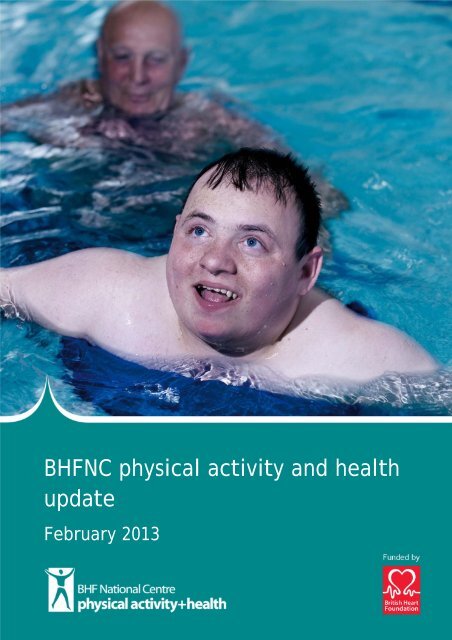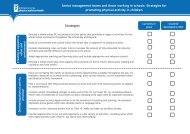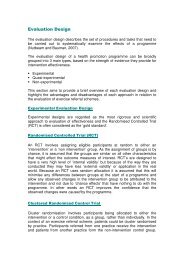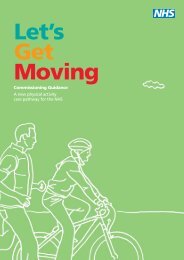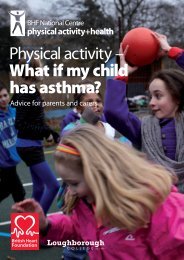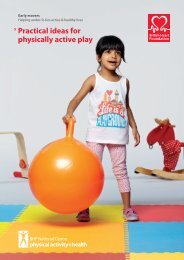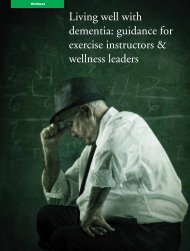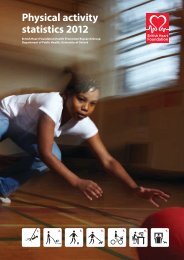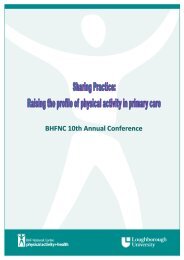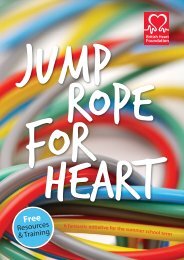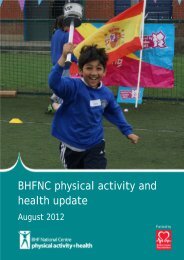BHFNC physical activity and health update - BHF National Centre ...
BHFNC physical activity and health update - BHF National Centre ...
BHFNC physical activity and health update - BHF National Centre ...
Create successful ePaper yourself
Turn your PDF publications into a flip-book with our unique Google optimized e-Paper software.
<strong><strong>BHF</strong>NC</strong> <strong>physical</strong> <strong>activity</strong> <strong>and</strong> <strong>health</strong><strong>update</strong>February 2013
<strong><strong>BHF</strong>NC</strong> <strong>physical</strong> <strong>activity</strong> <strong>and</strong> <strong>health</strong> <strong>update</strong>Inside this month’s <strong>update</strong><strong><strong>BHF</strong>NC</strong> project news Page 3Update from the <strong>BHF</strong> <strong>National</strong> <strong>Centre</strong> Early movers – new early years resource Physical <strong>activity</strong> patterns fact sheets Promoting <strong>health</strong> behaviour change training Olympic Legacy TrainingNew resources from the British Heart Foundation Take Away Health Lessons Heart Information Series new bookletsPublications of interest from other organisations Physical <strong>activity</strong> learning note Action on obesity: Comprehensive care for all A Dose of Localism: The Role of Councils inPublic HealthBritish Heart Foundation news Page 12Publications Page 14NICE local government public <strong>health</strong> briefingson walking <strong>and</strong> cycling <strong>and</strong> behaviour changeConferences Page 18Conferences <strong>and</strong> events you may find relevant Obesity & Related Conditions Scottish Sports Development Conference Sport <strong>and</strong> Physical Activity provision forChildren <strong>and</strong> Young People Obesity, Physical Activity <strong>and</strong> CancerNews Page 21Physical <strong>activity</strong> in the news Active People Survey 6 released Cricket Foundation report on impact ofOlympics 2011 <strong>National</strong> Travel Survey released She Moves campaignResearch of interest Page 23Healthy Hearts in theClassroom<strong><strong>BHF</strong>NC</strong> in partnership withthe British HeartFoundation (<strong>BHF</strong>) will bedelivering a number of newHealthy Hearts in theClassroom workshops. Thisfree interactive workshopis designed to showcase arange of <strong>BHF</strong> resourcessuitable for use in aprimary school setting.Healthy hearts in the classroom is provingto be a popular workshop with eight moreplanned for the first half of 2013 which willbe taking place in the following areas:Clevel<strong>and</strong> - Thursday 7 FebruaryRedruth, Cornwall - Thursday 12 FebruaryWatford - Thursday 12 MarchSouthend - Monday 18 MarchGloucester - Wednesday 24 AprilPeterborough - Monday 20 MayDundee - Friday 24 MayDerby - Monday 29 MayFor more information, please contactMargaret Couldwell onm.couldwell@lboro.ac.uk or phone 01509226418Recent <strong>physical</strong> <strong>activity</strong> researchPage 2
<strong><strong>BHF</strong>NC</strong> <strong>physical</strong> <strong>activity</strong> <strong>and</strong> <strong>health</strong> <strong>update</strong><strong><strong>BHF</strong>NC</strong> project newsEarly movers – new early years resourceThe British Heart Foundation (<strong>BHF</strong>) has just published a new early years<strong>physical</strong> <strong>activity</strong> guide. This pack is designed to help early yearspractitioners plan <strong>and</strong> organise <strong>physical</strong>ly active play environments forchildren under five.Written <strong>and</strong> collated by the <strong>BHF</strong> <strong>National</strong> <strong>Centre</strong>, the Early movers guidehelps early years settings build on existing practices by supporting a wholesetting approach to <strong>physical</strong> <strong>activity</strong>. It also provides innovative ideas toextend <strong>physical</strong> <strong>activity</strong> provision.This guide is relevant to all settings who provide care to children frombirth up to the age of five. It can also be used by professionals whoprovide support to settings, such as <strong>health</strong> improvement officers or earlyyears advisers, where <strong>physical</strong> <strong>activity</strong> may be one element of a focus on<strong>health</strong>y lifestyles.What’s included?Seven booklets for early years practitioners to help plan, organise <strong>and</strong> deliver <strong>physical</strong> <strong>activity</strong>with the under 5s.1. Early movers – An introduction to the guideProvides an overview of the content of the guide including a list of useful resources forfurther information <strong>and</strong> support.2. Introduction to <strong>physical</strong> <strong>activity</strong> in the early yearsIncludes the UK <strong>physical</strong> <strong>activity</strong> guidelines for under 5s <strong>and</strong> explains how the guide supportsUK early years curriculum areas of development.3. Planning <strong>and</strong> organisation for early years managersExplains how to develop a whole setting approach to <strong>physical</strong> <strong>activity</strong>,audit current provision <strong>and</strong> plan a <strong>physical</strong> <strong>activity</strong> policy.4. Getting the best from your environmentProvides ideas to create enabling environments for <strong>physical</strong>ly activeplay <strong>and</strong> ideas for how to reduce sitting time.5. Practical ideas for <strong>physical</strong>ly active playIdeas for planning <strong>physical</strong> activities for all stages of developmentfrom non-walkers to pre-schoolers.6. Getting children involvedConsiders the principle of inclusion <strong>and</strong> how to get a balance of childinitiated<strong>and</strong> adult-led activities, as well as developing skills forencouraging different types of play.7. Getting parents <strong>and</strong> carers involvedIdeas for encouraging parent <strong>and</strong> carer support, building partnerships<strong>and</strong> promoting family <strong>physical</strong> <strong>activity</strong> beyond the setting.Page 3
<strong><strong>BHF</strong>NC</strong> <strong>physical</strong> <strong>activity</strong> <strong>and</strong> <strong>health</strong> <strong>update</strong>One copy of Help your baby move <strong>and</strong> play every day<strong>and</strong> Help your child move <strong>and</strong> play every day leafletsThese include tips <strong>and</strong> ideas for parents <strong>and</strong> carers onencouraging their children to be active every day.One height chart for parents <strong>and</strong> carers to log theirchild’s height as they grow <strong>and</strong> developmental firsts asthey progress.Stickers to reward children or use on play equipmentaround the setting.Six Early movers posters with key <strong>physical</strong> <strong>activity</strong>messages for use in an early years setting.Early movers introduces <strong>physical</strong> <strong>activity</strong> in the early years <strong>and</strong> gives information <strong>and</strong> ideas onplanning <strong>and</strong> organising provision as well as practical activities <strong>and</strong> getting children, parents<strong>and</strong> carers involved.How to orderTo download the booklets <strong>and</strong> leaflets included in the pack visit www.bhfactive.org.ukTo order your copy of the Early movers pack visit the <strong>BHF</strong> website. All of the materials arefree but as a charity the <strong>BHF</strong> very much welcome <strong>and</strong> appreciate donations to help towardstheir costs.You can also order by ringing the <strong>BHF</strong> Orderline on 0870 600 6566 or emailorderline@bhf.org.uk <strong>and</strong> quoting order reference G609.Page 4
<strong><strong>BHF</strong>NC</strong> <strong>physical</strong> <strong>activity</strong> <strong>and</strong> <strong>health</strong> <strong>update</strong>Physical <strong>activity</strong> patterns in children fact sheetsThese latest <strong><strong>BHF</strong>NC</strong> fact sheets provide current statistics onthe <strong>physical</strong> <strong>activity</strong> behaviours of children in Scotl<strong>and</strong> <strong>and</strong>Wales.They include all the latest facts <strong>and</strong> figures from nationalsurveys in Scotl<strong>and</strong> <strong>and</strong> Wales to provide a picture of howactive children are. These fact sheets include informationon: the percentage of children meeting theGovernment’s <strong>physical</strong> <strong>activity</strong> guidelines travel to school data sedentary behaviour patterns provision of PE <strong>and</strong> sport in schools.Similar fact sheets with information on Engl<strong>and</strong> <strong>and</strong> Northern Irel<strong>and</strong> will follow soon.Download: Physical <strong>activity</strong> patterns - Children in Scotl<strong>and</strong>Download: Physical <strong>activity</strong> patterns - Children in WalesPage 5
<strong><strong>BHF</strong>NC</strong> <strong>physical</strong> <strong>activity</strong> <strong>and</strong> <strong>health</strong> <strong>update</strong>Make a MoveMake a Move is a new programme from the British HeartFoundation which uses an innovative approach toincrease the <strong>physical</strong> <strong>activity</strong> levels of young people insecondary schools, in particular the least active. Theprogramme addresses young people’s motivation tobecome more <strong>physical</strong>ly active <strong>and</strong> improves theirconfidence. Rather than prescribing a particular type of<strong>physical</strong> <strong>activity</strong>, it encourages individuals to identifythe ways of becoming more active that are right forthem.The programme is aimed at pupils in Key Stage 3 <strong>and</strong>consists of two str<strong>and</strong>s: eight class-based activities designed to be used in Personal, social <strong>and</strong> <strong>health</strong> education(PSHE) or tutor time with a group of pupils with different <strong>activity</strong> levels a peer mentoring scheme aimed at the least active.The Make a Move toolkit, written by the <strong>BHF</strong> <strong>National</strong> <strong>Centre</strong>, supports the programme <strong>and</strong> isdesigned for non PE specialists working in, or with, secondary schools, <strong>and</strong> in particularteachers of PSHE.Following a successful pilot in 2012 it is anticipated that the programme will be made availableto all secondary schools in the UK from March 2013.For more information about the programme please contact Hannah Hall onh.m.l.hall@lboro.ac.uk or Anna Chalkley on a.e.chalkley@lboro.ac.ukPage 6
<strong><strong>BHF</strong>NC</strong> <strong>physical</strong> <strong>activity</strong> <strong>and</strong> <strong>health</strong> <strong>update</strong>Olympic Legacy TrainingThe <strong><strong>BHF</strong>NC</strong>, on behalf of the British Heart Foundation, willbe embarking on the second half of our Olympic Legacy tourconsisting of ten free training dates for anyone working withor promoting <strong>physical</strong> <strong>activity</strong> to children <strong>and</strong> young people.The training days offer a once only opportunity forparticipants to access free training <strong>and</strong> resources around oneof three workshop themes.1. Early movers – helping under 5s live active <strong>and</strong> <strong>health</strong>ylives (half day)* A half day workshop for early years practitioners. Underst<strong>and</strong>ing <strong>and</strong> putting into practice the UK<strong>physical</strong> <strong>activity</strong> guidelines for early years. A practical workshop which is interactive <strong>and</strong> engaging.2. Engaging primary aged children in <strong>physical</strong> <strong>activity</strong> (half day)* A half day interactive workshop. Tried <strong>and</strong> tested techniques for achieving inclusion across all abilities. A variety of activities to increase children <strong>and</strong> young people’s awareness of thebenefits of being active.3. Motivating the least active secondary aged pupils (full day) Introducing the innovative Make a Move resource (formerly called Secondary ActiveSchools) for 11–14 year olds. Helping to change young people’s behaviour in favour of being active. Techniques for use in schools.Training dates are listed below. Hastings - 6 March Rotherham – 13 March Torfaen, Wales – 20 March Cookstown, Northern Irel<strong>and</strong> – 17 April Hartlepool – 24 April Blackpool - 1 May Kings Lynn - 15 May Cornwall – 22 May Newham, London – 5 June Dundee, Scotl<strong>and</strong> - TBCFor more information about the day please contact Anna Chalkley a.e.chalkley@lboro.ac.ukTo book your place either visit www.bhfactive.org.uk to download a booking form or contactElizabeth Mayne on e.c.mayne@lboro.ac.uk or 01509 226419.* These workshops will be repeated in the afternoon if there is sufficient interest.Page 7
<strong><strong>BHF</strong>NC</strong> <strong>physical</strong> <strong>activity</strong> <strong>and</strong> <strong>health</strong> <strong>update</strong>Physical <strong>activity</strong> for allThis course provides professionals with the knowledge<strong>and</strong> practical skills to plan <strong>and</strong> safely adapt <strong>physical</strong><strong>activity</strong> sessions for children <strong>and</strong> young people withlong term medical conditions. The course focusesspecifically on asthma, diabetes, obesity <strong>and</strong> congenitalheart conditions.This training is suitable for professionals who aredirectly responsible for delivering <strong>physical</strong> <strong>activity</strong>sessions with children <strong>and</strong> young people. For exampleteachers, early years workers, youth workers,lunchtime supervisors <strong>and</strong> many more.New dates for 2013 Wednesday 17 April Tuesday 18 June Tuesday 15 October Tuesday 26 NovemberDelegates will receive the course manual four weeks prior to the start of the course to allowthem time to study this in advance. The course includes a one day contact session involvingsome practical content. Courses will take place at Loughborough University.The cost for this course is £125 for the statutory sector <strong>and</strong> £100 for the voluntary sector.For further information <strong>and</strong> to book your place contact Elizabeth Mayne on 01509 226419 oremail e.c.mayne@lboro.ac.ukClick here to download a booking formPage 8
<strong><strong>BHF</strong>NC</strong> <strong>physical</strong> <strong>activity</strong> <strong>and</strong> <strong>health</strong> <strong>update</strong>Promoting <strong>health</strong> behaviour changeThis two-day course teaches key Solution Focused skills tohelp promote <strong>health</strong> <strong>and</strong> wellbeing in routineconsultations with clients. The course is suitable foranyone who works as a frontline <strong>health</strong>care professional.A Solution Focused approach focuses on what clients wantto achieve rather than on the problem(s) that they maycurrently have.This course will give delegates the skills to: proactively <strong>and</strong> sensitively empower individualstowards <strong>health</strong>ier lifestyles activate self-management of long-termconditions harness individuals' strengths <strong>and</strong> resources to develop personalised <strong>health</strong> solutions maximise outcomes within short time frames.Previous participants are reporting these new skills revolutionise their practice <strong>and</strong> areapplicable to primary, community <strong>and</strong> hospital services (individual face-to-face interactions,groups <strong>and</strong> telephone-based care).<strong><strong>BHF</strong>NC</strong> will be hosting two-day Promoting <strong>health</strong> behaviour change courses at LoughboroughUniversity on the following dates: 12-13 March 2013 14-15 May 2013 24-25 September 2013 3-4 December 2013We also offer this as a bespoke training course at a venue to suit you. For further details aboutthe Promoting <strong>health</strong> behaviour change course <strong>and</strong> bespoke options contact Elizabeth Mayne on01509 226419 or email e.c.mayne@lboro.ac.ukTo book your place download the booking form.Please note this course has previously been called Patient Empowerment.Page 9
<strong><strong>BHF</strong>NC</strong> <strong>physical</strong> <strong>activity</strong> <strong>and</strong> <strong>health</strong> <strong>update</strong>Physical <strong>activity</strong> patterns in adults fact sheetsThese latest <strong><strong>BHF</strong>NC</strong> fact sheets provide up-to-date facts<strong>and</strong> figures on the <strong>physical</strong> <strong>activity</strong> behaviours of adultsin Scotl<strong>and</strong> <strong>and</strong> Wales.They pull together all the latest statistics from sourcessuch as the Scottish <strong>and</strong> Welsh Health Surveys <strong>and</strong><strong>National</strong> Travel Surveys to provide a picture of howactive adults in Scotl<strong>and</strong> <strong>and</strong> Wales are.These fact sheets include information on: the numbers of adults in different age groupsmeeting the Government’s <strong>physical</strong> <strong>activity</strong>guidelines statistics on outdoor recreation data on personal travel sedentary behaviour patterns.Similar fact sheets with information on Engl<strong>and</strong> <strong>and</strong> Northern Irel<strong>and</strong> will follow soon.Download: Physical <strong>activity</strong> patterns – Adults in Scotl<strong>and</strong>Download: Physical <strong>activity</strong> patterns – Adults in WalesPage 10
<strong><strong>BHF</strong>NC</strong> <strong>physical</strong> <strong>activity</strong> <strong>and</strong> <strong>health</strong> <strong>update</strong>Project <strong>update</strong> on <strong>physical</strong> <strong>activity</strong> in the early yearsThe <strong><strong>BHF</strong>NC</strong>, Leicester-Shire & Rutl<strong>and</strong> Sport <strong>and</strong> NHSLeicester City are halfway through their joint early years<strong>physical</strong> <strong>activity</strong> training project in Leicester City, whichbegan in July 2012. During Phase 1 (Sept to Dec 2012)nursery staff were offered two training sessions focusing onthe importance of <strong>physical</strong> <strong>activity</strong> for children who cannotyet walk <strong>and</strong> for those who have just started. They wereprovided with <strong>activity</strong> tips to help promote <strong>physical</strong>development. Additional follow-up support <strong>and</strong> resourceswere offered by the trainer during casual visits to eachsetting <strong>and</strong> a sharing practice meeting was held.Interviews to assess the impact of Phase 1 on practitioners’knowledge of <strong>physical</strong> <strong>activity</strong> <strong>and</strong> <strong>activity</strong> provision within the nursery were completed duringearly January 2013. Preliminary findings suggest that between baseline <strong>and</strong> the end of Phase 1: practitioners increased their knowledge <strong>and</strong> underst<strong>and</strong>ing of why <strong>physical</strong> <strong>activity</strong> isimportant for the development of children who are not yet walking all settings made changes to their <strong>physical</strong> <strong>activity</strong> provision including increasingprovision of ‘tummy time’ <strong>and</strong> scheduling in ‘vest time’ throughout the week some nurseries were able to make changes to their room layout to better allow for<strong>physical</strong> activities even without specific training, practitioners were more confident in explaining thebenefits <strong>and</strong> importance of <strong>physical</strong> <strong>activity</strong> to parents.These preliminary findings suggest that training, informal support <strong>and</strong> resources may be helpfulin supporting practitioners deliver the revised Early Years Foundation Stage (EYFS) byenhancing their knowledge relating to <strong>physical</strong> development.Phase 2 of this project, focusing on practitioners’ interactions with parents, is currentlyunderway <strong>and</strong> will run between January <strong>and</strong> March 2013. For more information on this projectcontact Mary Goad on m.a.goad@lboro.ac.ukPage 11
<strong><strong>BHF</strong>NC</strong> <strong>physical</strong> <strong>activity</strong> <strong>and</strong> <strong>health</strong> <strong>update</strong>British Heart Foundation newsTake Away Health LessonsThe <strong>BHF</strong> has launched a new resource for Personal, social,<strong>health</strong> education teachers working with 11–14 year olds. TakeAway Health Lessons includes 12 flashcards <strong>and</strong> 12 60 minutelesson plans to help students underst<strong>and</strong> the importance of<strong>health</strong>y eating in a fun <strong>and</strong> interactive way.The pack also includes activities, discussion topics, recipes,teachers’ notes <strong>and</strong> curriculum links (for all the homecountries) to encourage young people to think about their ownhabits <strong>and</strong> make <strong>health</strong>y choices.Each pack includes 12 A4 booklets, each with an accompanyingflashcard.To order your Take Away Health Lessons visit the <strong>BHF</strong> websitewww.bhf.org.uk/publicationsYou can also order over the phone by calling 0870 600 6566 or email orderline@bhf.org.ukquoting order code G435. <strong>BHF</strong> resources are free of charge but as a charity they wouldappreciate a donation to help cover their costs. The suggested donation for this resource is £15.Page 12
<strong><strong>BHF</strong>NC</strong> <strong>physical</strong> <strong>activity</strong> <strong>and</strong> <strong>health</strong> <strong>update</strong>Heart Information SeriesBelow are two of the latest publications from the <strong>BHF</strong>’s Heart Information Series (HIS). Thebooklets explain about heart <strong>health</strong>, specific conditions <strong>and</strong> treatment in clear simplelanguage.HIS 13 Heart transplantationThis booklet is for people who may need a heart transplant,<strong>and</strong> for their family <strong>and</strong> friends. It explains: who is accepted for a heart transplant what happens during an assessment <strong>and</strong> a transplant what happens once a patient is accepted for atransplant what happens after the operation.It also describes: the medicines given after a transplant life after a transplant the long-term outlook for heart transplant patients possible complications.HIS 10 Coronary angioplastyThis booklet explains: who needs to have a coronary angioplasty what happens in a coronary angioplasty how successful it is what patients can do to help themselves after havingan angioplasty.The booklet also describes what heart <strong>and</strong> circulatory diseaseis, to help patients underst<strong>and</strong> why they may need a coronaryangioplasty.Both booklets <strong>and</strong> others in the Heart Information Series can be downloaded or ordered atwww.bhf.org.uk/publicationsPage 13
<strong><strong>BHF</strong>NC</strong> <strong>physical</strong> <strong>activity</strong> <strong>and</strong> <strong>health</strong> <strong>update</strong>PublicationsNew <strong>physical</strong> <strong>activity</strong> learning noteNHS Scotl<strong>and</strong> has produced a summary document of twoprojects they previously commissioned to help <strong>health</strong>professionals underst<strong>and</strong> the key themes that motivate peopleto become more active.The projects previously commissioned looked at thedevelopment of key themes for <strong>physical</strong> <strong>activity</strong> promotion forthe early years <strong>and</strong> children <strong>and</strong> young people with a separatereport looking at adults <strong>and</strong> older adults.This learning note brings together the findings from each report<strong>and</strong> presents a number of themes <strong>and</strong> key learning points thatshould be considered by professionals in the promotion of<strong>physical</strong> <strong>activity</strong> across all life stages, <strong>and</strong> some life stagespecific considerations. Themes covered in this report include: benefits of <strong>physical</strong> <strong>activity</strong> motivating language key people/places to raise the issue preferred activities.This information can be used to help the development of <strong>physical</strong> <strong>activity</strong> interventions, frombrief advice through to programme development <strong>and</strong> print publications.Click here for further information on the previously commissioned reports.Download: Development of key themes for <strong>physical</strong> <strong>activity</strong> promotion learningnotePage 14
<strong><strong>BHF</strong>NC</strong> <strong>physical</strong> <strong>activity</strong> <strong>and</strong> <strong>health</strong> <strong>update</strong>Action on obesity: Comprehensive care for allThe Royal College of Physicians has published Action onobesity: Comprehensive care for all a working party reporton obesity in Britain.The cost of dealing with the <strong>health</strong> problems caused byobesity is estimated at £5 billion a year <strong>and</strong> is predicted todouble by 2050. Currently around 25% of UK adults areobese. This report looks at the issues surrounding obesity<strong>and</strong> makes a number of recommendations as to how the NHS<strong>and</strong> other organisations should address these.The recommendations made in the report include: developing <strong>and</strong> integrating weight managementservices with those <strong>health</strong>care services thatmanage the complications <strong>and</strong> conditions whicharise from obesity a multidisciplinary team approach to weight management <strong>and</strong> bariatric surgery toinclude specialist consultant physicians, consultant surgeons, dietitians, nurses,psychologists <strong>and</strong> psychiatrists <strong>and</strong> exercise/<strong>physical</strong> <strong>activity</strong> professionals commissioners ensuring that every NHS trust has a medical obesity spokesman or‘champion’ who, amongst other things, can communicate with commissioners,providers <strong>and</strong> the community GPs, where possible <strong>and</strong> appropriate, to deal with weight issues as part of theiragenda to address risk factors GPs to have training in a range of practical behavioural techniques such as inmotivational interviewingThe report also suggests a number of ways in which employers should encourage <strong>physical</strong><strong>activity</strong> among their staff. These include: signposting to <strong>and</strong> encouraging the use of walking <strong>and</strong> cycling routes <strong>and</strong> stairs,including the provision of safe cycle storage areas recommending the use of active travel methods to <strong>and</strong> from work, <strong>and</strong> provision ofchanging room facilities working with local authorities to enhance access to <strong>health</strong> services by publictransport considering the use of staff incentives such as discounted membership of fitness clubs encouraging staff to take regular breaks to move around as well as sufficient time toeat well.Download: Action on obesity: Comprehensive care for allPage 15
<strong><strong>BHF</strong>NC</strong> <strong>physical</strong> <strong>activity</strong> <strong>and</strong> <strong>health</strong> <strong>update</strong>A Dose of Localism: The Role of Councils in Public HealthThis new report from the Local Government Information Unit(LGiU) suggests a bottom up approach is required from localauthorities to address public <strong>health</strong> issues such as obesity <strong>and</strong>diabetes.A Dose of Localism: The Role of Councils in Public Health,published with Westminster City Council, recommends that thisis characterised by early intervention <strong>and</strong> co-production. Andalso suggests there may be benefits to public <strong>health</strong> ofincentivising people to exercise.The report makes five recommendations to local governmenton how to face the increase in dem<strong>and</strong> for public <strong>health</strong> at afinancially challenging time.1. Innovate. Councils should design innovative servicesthat embed the public <strong>health</strong> approach across service areas.2. Show who benefits from invest to save. Public <strong>health</strong> analysis needs to build on thecommunity budget pilots to provide more robust cost benefit analysis of actions thatdeliver longer term savings from early intervention <strong>and</strong> preventative action <strong>and</strong> wherefuture benefits accrue.3. Recruit <strong>and</strong> develop community commissioners. The key to realising <strong>health</strong> gains isgiving communities real decision-making power. One option is to employ communitycommissioners.4. Identify <strong>and</strong> build on success. Local authorities should focus on strengthening preexistingnetworks in communities that could play a role in delivering services.5. Councillors as community leaders. Ward councillors are the direct link between thelocal authority <strong>and</strong> the community. They are best-placed to encourage people to getinvolved in improving public <strong>health</strong> outcomes.The authors of this report hope it will help stimulate debate about what effective localgovernment leadership of public <strong>health</strong> looks like.Download: A Dose of Localism: The Role of Councils in Public HealthPage 16
<strong><strong>BHF</strong>NC</strong> <strong>physical</strong> <strong>activity</strong> <strong>and</strong> <strong>health</strong> <strong>update</strong>NICE local government public <strong>health</strong> briefingsNICE has developed two new local government public <strong>health</strong>briefings, one on walking <strong>and</strong> cycling <strong>and</strong> the other onbehaviour change.These briefings are designed for local authorities <strong>and</strong> theirpartner organisations in the <strong>health</strong> <strong>and</strong> voluntary sectors; inparticular those involved with <strong>health</strong> <strong>and</strong> wellbeing boards.They may also be useful in the development of joint <strong>health</strong> <strong>and</strong>wellbeing strategies.Walking <strong>and</strong> cyclingThis briefing summarises NICE's recommendations for localauthorities <strong>and</strong> partner organisations on walking <strong>and</strong> cycling. Itsuggests conditions that encourage walking <strong>and</strong> cycling can alsohelp create an environment that supports the local economy.The briefing recommends a number of key changes which local governments can make toencourage walking <strong>and</strong> cycling. These include addressing issues such as: walking <strong>and</strong> cycling networks <strong>and</strong> infrastructure key barriers such as road safety road safety partnerships motor vehicle speed.The document also suggests development of local programmes to support walking <strong>and</strong> cycling<strong>and</strong> outlines the costs <strong>and</strong> savings of increasing levels.Behaviour changeThis briefing covers <strong>health</strong>-related behaviour change interventions <strong>and</strong> outlines what iseffective <strong>and</strong> what programmes can achieve.The briefing covers areas such as: planning interventions social context evaluation <strong>and</strong> training.The document also shows examples of good practice <strong>and</strong> includes planning <strong>and</strong> commissioningquestions to ask before beginning an intervention.Download: Local government public <strong>health</strong> briefing on walking <strong>and</strong> cyclingDownload: Local government public <strong>health</strong> briefing on behaviour changePage 17
<strong><strong>BHF</strong>NC</strong> <strong>physical</strong> <strong>activity</strong> <strong>and</strong> <strong>health</strong> <strong>update</strong>Conferences <strong>and</strong> eventsAdvancing the Global Non-Communicable Disease Movement11-12 February 2013London School of Hygiene <strong>and</strong> Tropical Medicine (LSHTM)Price £20 per dayThis two-day event features a different focus for each day.Day one will see the launch of a new Lancet series on non-communicable diseases (NCDs) <strong>and</strong>development. Sessions will aim to reflect on the five themes covered by the papers in theseries: convening partners to align around action, disseminating knowledge for action,advocacy to deliver the agreed mortality reduction goal, ensuring accountability <strong>and</strong>resourcing <strong>and</strong> the post-2015 development agenda.The second day will feature the second annual symposium of the LSHTM <strong>Centre</strong> for Global NCDswith the <strong>Centre</strong> on Global Change <strong>and</strong> Health. Sessions will focus on preventing global NCDsthrough low carbon development.For further information visit www.globalncd2013.eventbrite.comFit 4 Women 2013 conferenceReading, Hilton Reading hotel – Tuesday 26 February 2013Manchester, Radisson Blu Hotel Manchester Airport – Thursday 28 February 2013Price £80 + VATThis event aims to provide delegates with an opportunity to explore the challenges inincreasing women <strong>and</strong> girls’ participation in sport.Hosted by Jeanette Kwakye (2008 Olympic Games 100m Finalist), the Fit 4 Women event aimsto bring together those who work in delivery at local <strong>and</strong> regional levels to share theirexperiences <strong>and</strong> challenges, <strong>and</strong> connect with a broad network of peers from the sector.The event will include a panel discussion, Q&A session as well as hearing from a London 2012guest.For more information visit www.fit4women.co.ukPage 18
<strong><strong>BHF</strong>NC</strong> <strong>physical</strong> <strong>activity</strong> <strong>and</strong> <strong>health</strong> <strong>update</strong>Obesity & Related Conditions: Tackling an Epidemic27 February 2013Manchester Conference <strong>Centre</strong>Prices £295-£895 + VATThis conference will explore what action can be taken to combat raising obesity levels. Theagenda will debate the key issues associated with individual behaviour, government legislation,food production <strong>and</strong> labelling, <strong>physical</strong> <strong>activity</strong>, childhood obesity <strong>and</strong> medical <strong>and</strong> financialinterventions.Topics to be discussed include: supporting <strong>health</strong>ier lifestyles, building local capability obesity <strong>and</strong> <strong>health</strong> inequalities: is a new approach needed? local leadership, local action, local views tackling childhood obesity interventions: Is anything working?For more information visitwww.publicserviceevents.co.uk/238/obesity-<strong>and</strong>-related-conditionsObesity, Physical Activity <strong>and</strong> Cancer16-17 April 2013London UKPrice £250-£300World Cancer Research Fund International (WCRF) <strong>and</strong> the International Association for theStudy of Obesity (IASO) are hosting a joint Hot Topic Conference on Obesity, Physical Activity<strong>and</strong> Cancer.The scientific sessions will examine the links between obesity, <strong>physical</strong> <strong>activity</strong> <strong>and</strong> cancerincidence <strong>and</strong> survival. Session topics will include: obesity, <strong>physical</strong> <strong>activity</strong> <strong>and</strong> cancer prevention evidence for the relationship between <strong>physical</strong> <strong>activity</strong> <strong>and</strong> cancer incidence <strong>and</strong>survival life course factors <strong>and</strong> cancer (incidence <strong>and</strong> survival)For further details visit www.wcrf.org/conferencesPage 19
<strong><strong>BHF</strong>NC</strong> <strong>physical</strong> <strong>activity</strong> <strong>and</strong> <strong>health</strong> <strong>update</strong>Scottish Sports Development Conference22-23 April 2013The Westerwood Hotel, CumbernauldPrice £150-£345 + VATThis conference aims to bring together delegates from all levels of sport development, fromgrassroots development officers to senior managers, from local authorities, the voluntarysector <strong>and</strong> national governing bodies within Scotl<strong>and</strong>.This year’s theme is based on Our Sporting Communities – Investing in the future. Theconference is supported by sportscotl<strong>and</strong> <strong>and</strong> is designed for professionals in sport <strong>and</strong> <strong>physical</strong><strong>activity</strong>, working either in teams or independently throughout Scotl<strong>and</strong>. It will focusspecifically on mainstream sport development in Scotl<strong>and</strong>, although it will draw on the widerUK sport development experience.For further information visit www.ssdc.org.ukKeep up-to-date on <strong>physical</strong> <strong>activity</strong> <strong>and</strong> <strong>health</strong>To join the <strong><strong>BHF</strong>NC</strong> database <strong>and</strong> receive our <strong>update</strong>sstraight to you inbox click here <strong>and</strong> sign up to ourdatabaseIf you have any questions or would like us to consideryour news for our next <strong>update</strong> please email us onbhfnc@lboro.ac.uk or call 01509 226421You can also follow us on Twitter @<strong>BHF</strong>activePage 20
<strong><strong>BHF</strong>NC</strong> <strong>physical</strong> <strong>activity</strong> <strong>and</strong> <strong>health</strong> <strong>update</strong>NewsActive People Survey 6 releasedThe latest release of data from Sport Engl<strong>and</strong>’s Active PeopleSurvey shows a statistically significant increase in sportsparticipation. This equates to 15.5 million adults taking part insport at least once a week for 30 minutes at moderate intensity.Over 57% of those questioned had done no 30 minute sessions,of at least moderate intensity, in the previous 28 daysThe Active People Survey is Sport Engl<strong>and</strong>’s main participationmeasure <strong>and</strong> is based on the percentage of adults (aged 16+)participating in at least 30 minutes of sport at moderate intensity at least once a week.The survey shows that sports that are growing in popularity are athletics, judo, tennis <strong>and</strong>swimming.For more information <strong>and</strong> detailed results visit the Sport Engl<strong>and</strong> websiteCricket Foundation report on impact of OlympicsThis report, commissioned by the Cricket Foundation, analysesthe impact the 2012 Olympic <strong>and</strong> Paralympic Games has had onschool sport in Britain.They surveyed 1,006 parents of children aged between 5-16about their child’s sporting habits post the 2012 Games.Over half of parents polled said the Olympics have inspired theirchildren to do more sport in some way; 15% said their child nowdoes more sport outside of school <strong>and</strong> 9% do more sport inschool.Nearly eight out of ten parents also said the amount of PE <strong>and</strong> games done in school has stayedthe same as before the Olympics, with half saying that their child did fewer than two hours aweek of PE or games lessons at school. One in ten parents said their child wanted to do moresport after the Olympics, but there were no opportunities for them to do so at school.Download: Being Active – The Cricket Foundation surveyFor further information on this report visit www.chancetoshine.orgPage 21
<strong><strong>BHF</strong>NC</strong> <strong>physical</strong> <strong>activity</strong> <strong>and</strong> <strong>health</strong> <strong>update</strong>2011 <strong>National</strong> Travel Survey releasedThe 2011 <strong>National</strong> Travel Survey (NTS) is the latest release ina series of household surveys of personal travel in GreatBritain. The survey is designed to track long-termdevelopment of trends in travel, although short-term changescan also be detected.NTS data is collected through interviews with people in theirhomes, <strong>and</strong> a diary that they keep for a week to record theirtravel. The NTS covers travel by all age groups, includingchildren. In 2011, diary data was collected from 7,700households, covering over 18,000 individuals.Key findings In 2011, 49% of trips to <strong>and</strong> from school by primary school children (aged 5-10) weremade on foot. This was slightly lower than in 1995/97 when 53% of trips were madeon foot. Among secondary school children (aged 11-16) in 2011, 38% of school trips were onfoot compared with 42% in 1995/97. In 2011, the average number of walking trips was 222 trips per person per yearcompared with 292 trips in 1995/97, a decrease of 24%. 79% of all trips less than one mile in length were walking trips. Only 2% of all trips were made by bicycle. However, in terms of distance travelled,the average number of bicycle miles has increased by 14% from 43 miles in 1995/97 to49 miles in 2011.Download: <strong>National</strong> Travel Survey: 2011She Moves campaignThe Women’s Sport <strong>and</strong> Fitness Foundation has launchedtheir She Moves campaign to make more women move more.The campaign features a website designed for women toshare their experiences, share tips on getting active <strong>and</strong>support <strong>and</strong> inspire each other. The promotion centresaround Avril, a busy mum <strong>and</strong> wife who wants to lead a moreactive life. Users can keep up with Avril’s progress viaTwitter <strong>and</strong> blogs.For further information visitwww.wsff.org.uk/shemoves/homePage 22
<strong><strong>BHF</strong>NC</strong> <strong>physical</strong> <strong>activity</strong> <strong>and</strong> <strong>health</strong> <strong>update</strong>Research of interestThe acute effects of <strong>physical</strong> <strong>activity</strong> on cigarette cravings: a systematic review<strong>and</strong> meta-analysis with individual participant dataHaasova M, Warren FC, Ussher M, Van Rensburg KJ, Faulkner G, Cropley M, et al.Addiction. 2013 Jan;108(1):26-37. doi: 10.1111/j.1360-0443.2012.04034.x.In the UK, 21% of adults smoke. While 63% of smokers want to give up, most who try relapsewithin the first 8 days. Physical <strong>activity</strong> is recommended as an aid for smoking cessation, butthere is only limited evidence to support its effectiveness.The purpose of this study was to review the evidence on the effectiveness of using short bouts of<strong>physical</strong> <strong>activity</strong> to reduce cigarette cravings.Authors reviewed both published <strong>and</strong> unpublished literature <strong>and</strong> contacted the study authors toobtain raw data. This allowed the reviewers to run a meta-analysis on individual data (the goldst<strong>and</strong>ard) rather than only analysing the results of the individual studies. To allow for the mostrobust comparison, in studies where there was more than one intervention group, data wascombined so the reviewers were only comparing two - control or treatment (ie, <strong>physical</strong><strong>activity</strong>).The two measures the researchers were interested in were strength of desire to smoke (SoD) <strong>and</strong>desire to smoke (DtS) after at least two hours of abstinence.Types of <strong>physical</strong> <strong>activity</strong> which were included in the treatment condition included treadmillrunning <strong>and</strong> walking, light, moderate <strong>and</strong> vigorous cycling, <strong>and</strong> isometric exercise.The results showed that all forms of <strong>physical</strong> <strong>activity</strong> reduced both SoD <strong>and</strong> DtS. Due to somestudies having results of higher significance than others, the reviewers decided to lookspecifically at moderate <strong>physical</strong> <strong>activity</strong> <strong>and</strong> effectiveness to reduce cravings. They found thatmoderate <strong>physical</strong> <strong>activity</strong> offered better results than light, moderate <strong>and</strong> vigorous intensitiescombined.Strength of desire tosmoke (SoD)Light, moderate <strong>and</strong> vigorous <strong>physical</strong><strong>activity</strong> intensities combined[Effect size (95% confidence interval)]Moderate intensity <strong>physical</strong> activities[Effect size (95% confidence interval)]-1.91 (-2.59 to -1.22) -2.20 (-2.89 to -1.51)Desire to smoke (DtS) -2.03 (-2.60 to -1.46) -2.14 (-2.71 to -1.57)*Note: An effect size closer to zero means that the intervention was less effective.Conclusions: Physical <strong>activity</strong> can reduce cravings <strong>and</strong> aid in smoking cessation. Furthermore,evidence suggests moderate <strong>physical</strong> <strong>activity</strong> may be more beneficial for reducing cravings thanlight or vigorous intensity activities.Page 23


